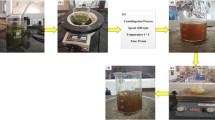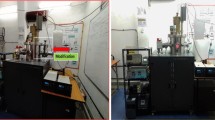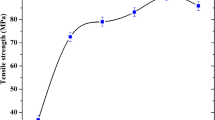Abstract
In the present environmental conditions bio usages has a vital importance in the society due to global warming and other environmental threats. In this work, alumina nano powder synthesized from ‘Neem’ leaf’ is used in sisal, coir and banana fiber composites for the betterment of mechanical and thermal applications. Thermo gravimetric analysis (TGA) contemplated biosynthesized alumina nano powder (BSANP-C) has better thermal stability than other nano powders. The mechanical results verified the enhancement of tensile, flexural and impact strength for hybrid banana coir (HBC), hybrid sisal coir (HSC) and hybrid sisal banana (HSB) composites up to 3% BSANP-C addition. Hybrid combination at 5% nano substitution tends to decrease the mechanical properties of hybrid composites due to agglomeration of BSANP-C making uneven mixing of filler in the matrix. The addition of BSANP-C wt% up to 3 in HBC, HSC and HSB ascertain residual % improvement from 18.72 to 23.41%, 21.90 to 25.75% and 22.69 to 26.33%. BSANP-C addition at 5% decreased the degradation temperature, char residual % and endothermic peak due to agglomeration. SEM test was taken for morphological study of fractured surface of the hybrid composites.















Similar content being viewed by others
References
Lee JM, Ishak ZAM, Taib RM et al (2013) Mechanical, thermal and water absorption properties of Kenaf-fiber-based polypropylene and poly (butylene succinate) composites. J Polym Environ 21:293–302. https://doi.org/10.1007/s10924-012-0516-4
Cordeiro EP, Pita VJRR, Soares BG (2016) Epoxy—fiber of peach palm trees composites: the effect of composition and fiber modification on mechanical and dynamic mechanical properties. J Polym Environ 25:913–924. https://doi.org/10.1007/s10924-016-0841-0
Prachayawarakorn J, Ruttanabus P (2011) Effect of cotton fiber contents and lengths on properties of thermoplastic starch composites prepared from rice and waxy rice starches. J Polym Environ 19:274–282. https://doi.org/10.1007/s10924-010-0273-1
Jaafar J, Parlaungan J, Mohd S et al (2018) Influence of selected treatment on tensile properties of short pineapple leaf fiber reinforced tapioca resin biopolymer composites. J Polym Environ 26:4271–4281. https://doi.org/10.1007/s10924-018-1296-2
Kureemun U, Ravandi M, Tran LQN et al (2018) Effects of hybridization and hybrid fibre dispersion on the mechanical properties of woven flax-carbon epoxy at low carbon fibre volume fractions. Compos B 134:28–38. https://doi.org/10.1016/j.compositesb.2017.09.035
Piyush P, Chaitanya S, Rahul S, Rana RS (2018) Evaluation of mechanical properties of coir and glass fiber hybrid composites. Mater Today Proc 5:19056–19062. https://doi.org/10.1016/j.matpr.2018.06.258
Živković I, Fragassa C, Pavlović A, Brugo T (2017) Influence of moisture absorption on the impact properties of flax, basalt and hybrid flax/basalt fiber reinforced green composites. Compos B 111:148–164. https://doi.org/10.1016/j.compositesb.2016.12.018
Li Xue, Lope G, Tabil SP (2007) Chemical treatments of natural fiber for use in natural fiber-reinforced composites: a review. J Polym Environ 15:25–33. https://doi.org/10.1007/s10924-006-0042-3
Ayd M, Tozlu H, Kemaloglu S (2011) Effects of alkali treatment on the properties of short flax fiber—poly (lactic acid) eco-composites. J Polym Environ 19:11–17. https://doi.org/10.1007/s10924-010-0233-9
Foulk JA, Chao WY, Akin DE et al (2006) Analysis of flax and cotton fiber fabric blends and recycled polyethylene composites. J Polym Environ 14:15–25. https://doi.org/10.1007/s10924-005-8703-1
Siddika S, Mansura F, Hasan M, Hassan A (2014) Effect of reinforcement and chemical treatment of fiber on the properties of jute-coir fiber reinforced hybrid polypropylene composites. Fibers Polym 15:1023–1028. https://doi.org/10.1007/s12221-014-1023-0
Idicula M, Joseph K, Thomas S (2010) Mechanical performance of short banana/sisal hybrid fiber reinforced polyester composites. J Reinf Plast Compos 29:12–29. https://doi.org/10.1177/0731684408095033
Venkateshwaran N, Elayaperumal A, Alavudeen A, Thiruchitrambalam M (2011) Mechanical and water absorption behaviour of banana/sisal reinforced hybrid composites. Mater Des 32:4017–4021. https://doi.org/10.1016/j.matdes.2011.03.002
Saw SK, Sarkhel G, Choudhury A (2012) Effect of layering pattern on the physical, mechanical, and thermal properties of jute/bagasse hybrid fiber-reinforced epoxy novolac composites. Polym Compos 33:1824. https://doi.org/10.1002/pc.22313
Boopalan M, Niranjanaa M, Umapathy MJ (2013) Study on the mechanical properties and thermal properties of jute and banana fiber reinforced epoxy hybrid composites. Compos B 51:54–57. https://doi.org/10.1016/j.compositesb.2013.02.033
Young J, Kyeong T, Jin H et al (2012) Thermal stability and flammability of coconut fiber reinforced poly (lactic acid) composites. Compos B 43:2434–2438. https://doi.org/10.1016/j.compositesb.2011.11.003
Ayrilmis N, Jarusombuti S, Fueangvivat V, Bauchongkol P (2011) Coir fiber reinforced polypropylene composite panel for automotive interior applications. Fibers Polym 12:919–926. https://doi.org/10.1007/s12221-011-0919-1
Gan P, Garbizu S, Llano-ponte R (2005) Surface modification of sisal fibers: effects on the mechanical and thermal properties of their epoxy. Polym Compos 26:121–127. https://doi.org/10.1002/pc.20083
Jarukumjorn K, Suppakarn N (2009) Effect of glass fiber hybridization on properties of sisal fiber—polypropylene composites. Compos B 40:623–627. https://doi.org/10.1016/j.compositesb.2009.04.007
Dhakal HN, Zhang ZY, Guthrie R et al (2013) Development of flax/carbon fibre hybrid composites for enhanced properties. Carbohydr Polym 96:1. https://doi.org/10.1016/j.carbpol.2013.03.074
Prasad CV, Sudhakara P, Prabhakar MN et al (2016) An investigation on the effect of silica aerogel content on thermal and mechanical properties of sisal/PLA nano composites. Polym Compos 39:835–840. https://doi.org/10.1002/pc.24005
Ibrahim ID, Jamiru T, Sadiku RE et al (2016) Dependency of the mechanical properties of sisal fiber reinforced recycled polypropylene composites on fiber surface treatment, fiber content and nanoclay. J Polym Environ 25:427–434. https://doi.org/10.1007/s10924-016-0823-2
Deka BK, Maji TK (2011) A Effect of TiO2 and nanoclay on the properties of wood polymer nanocomposite. Compos A 42:2117–2125. https://doi.org/10.1016/j.compositesa.2011.09.023
Abdul Khalil HPS, Masri M, Saurabh CK, Fazita MRN (2017) Incorporation of coconut shell based nanoparticles in kenaf/coconut fibres reinforced vinyl ester composites. Mater Res Express 4:1–20. https://doi.org/10.1088/2053-1591/aa62ec
Chaharmahali M, Hamzeh Y (2014) Effects of nano-graphene on the physico-mechanical properties of bagasse/polypropylene composites. Polym Bull 71:337–349. https://doi.org/10.1007/s00289-013-1064-3
Jiang W, Jin F, Park S (2012) Thermo-mechanical behaviors of epoxy resins reinforced with nano-Al2O3 particles. J Ind Eng Chem 18:594–596. https://doi.org/10.1016/j.jiec.2011.11.140
Omrani A, Simon LC, Rostami AA (2009) The effects of alumina nanoparticle on the properties of an epoxy resin system. Mater Chem Phys 114:145–150. https://doi.org/10.1016/j.matchemphys.2008.08.090
Zhao S, Schadler LS, Duncan R et al (2008) Mechanisms leading to improved mechanical performance in nanoscale alumina filled epoxy. Compos Sci Technol 68:2965–2975. https://doi.org/10.1016/j.compscitech.2008.01.009
Ahmed S, Ahmad M, Swami BL (2015) Green synthesis of silver nanoparticles using Azadirachta indica aqueous leaf extract. J Radiat Res Appl Sci 9:1–7. https://doi.org/10.1016/j.jrras.2015.06.006
Senthilkumar S, Rajendran A (2018) Biosynthesis of TiO2 nanoparticles using Justica gendarussa leaves for photocatalytic and toxicity studies. Res Chem Intermed 44:5923–5940. https://doi.org/10.1007/s11164-018-3464-3
Using N, Assal ME, Alkhathlan HZ, Al-warthan A (2017) Green synthesis and characterization of palladium nanoparticles using Origanum vulgare L. extract and their catalytic activity. Molecules 165:1–12. https://doi.org/10.3390/molecules22010165
Ansari MA, Khan HM (2015) Green synthesis of Al2O3 nanoparticles and their bactericidal potential against clinical isolates of multi-drug resistant Pseudomonas aeruginosa. World J Microbiol Biotechnol 31:153–164. https://doi.org/10.1007/s11274-014-1757-2
Sumesh KR, Kanthavel K, Vivek S (2019) Mechanical/thermal/vibrational properties of sisal, banana and coir hybrid natural composites by the addition of bio synthesized aluminium oxide nano powder. Mater Res Express 6:1–29. https://doi.org/10.1088/2053-1591/aaff1a
Vivek S, Kanthavel K (2018) Effect of bagasse ash filled epoxy composites reinforced with hybrid plant fibres for mechanical and thermal properties. Compos B 160:170–176. https://doi.org/10.1016/j.compositesb.2018.10.038
Lau K, Lu M (2005) Thermal and mechanical properties of single-walled carbon nanotube bundle-reinforced epoxy nanocomposites: the role of solvent for nanotube dispersion. Compos Sci Technol 65:719–725. https://doi.org/10.1016/j.compscitech.2004.10.005
Ahmed L, Zhang B, Shen R et al (2018) Fire reaction properties of polystyrene-based nanocomposites using nanosilica and nanoclay as additives in cone calorimeter test. J Thermal Anal Calorimetry. https://doi.org/10.1007/s10973-018-7127-9
Funding
No funding has been received for this work.
Author information
Authors and Affiliations
Corresponding author
Additional information
Publisher's Note
Springer Nature remains neutral with regard to jurisdictional claims in published maps and institutional affiliations.
Rights and permissions
About this article
Cite this article
Sumesh, K.R., Kanthavel, K., Ajithram, A. et al. Bioalumina Nano Powder Extraction and its Applications for Sisal, Coir and Banana Hybrid Fiber Composites: Mechanical and Thermal Properties. J Polym Environ 27, 2068–2077 (2019). https://doi.org/10.1007/s10924-019-01496-x
Published:
Issue Date:
DOI: https://doi.org/10.1007/s10924-019-01496-x




